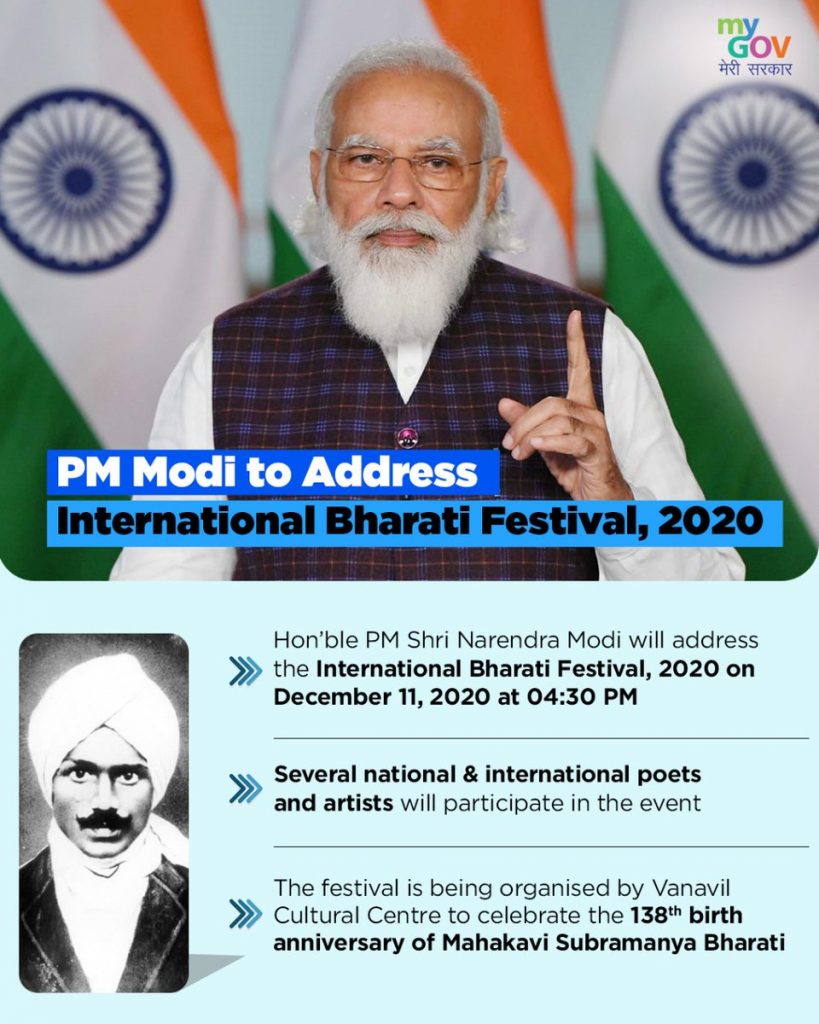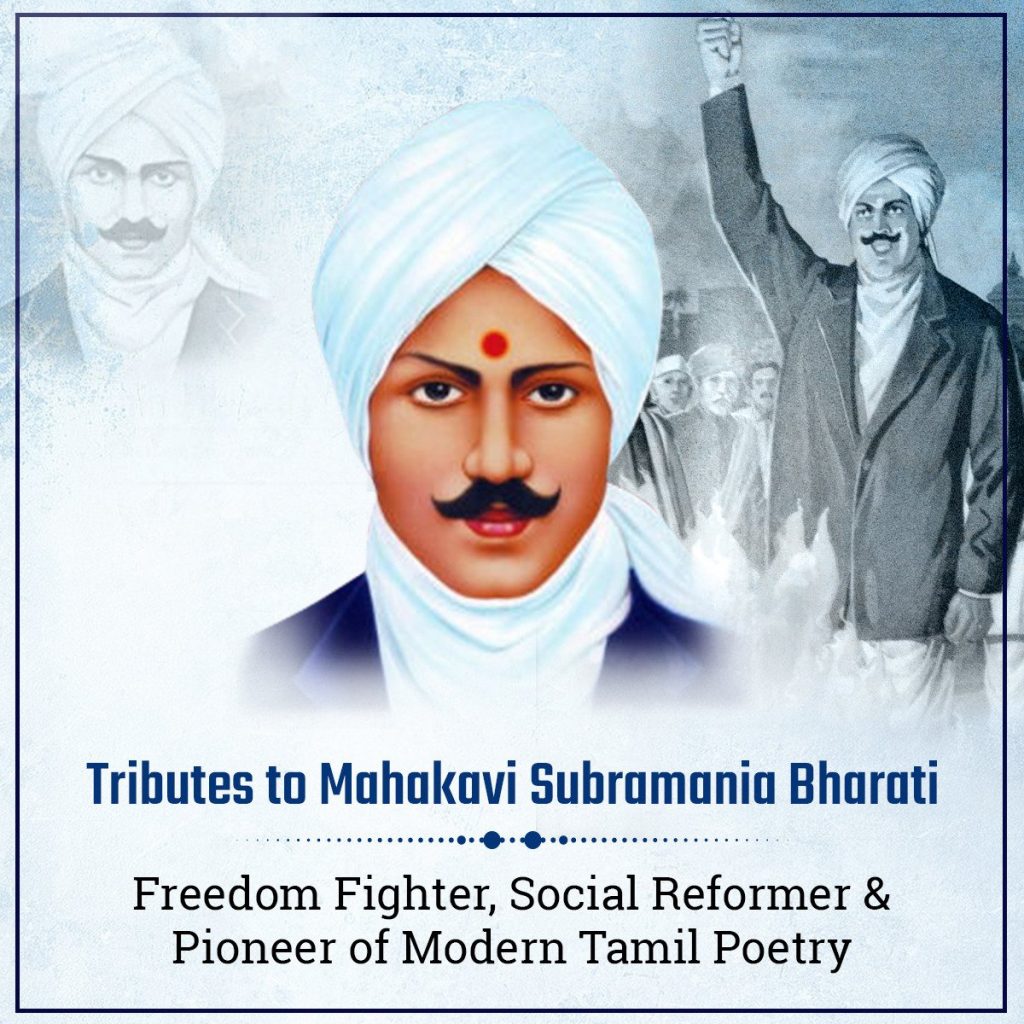Contents
- International Bharathi Festival 2020
- 5th India – Myanmar bilateral
INTERNATIONAL BHARATHI FESTIVAL 2020
Focus: GS1 ;Indian culture will cover the salient aspects of Art Forms, literature and Architecture from ancient to modern times.
Focus; GS1 ; The Freedom Struggle — its various stages and important contributors/contributions from different parts of the country.
Why in News?
PM addresses International Bharathi Festival 2020
About International Bharathi Festival 2020
- The Prime Minister Shri Narendra Modi addressed International Bharathi Festival 2020 through video conferencing and paid tributes to the Bharathiyar on his Jayanti.
- The festival is being organised by Vanavil Cultural Centre to celebrate the 138th birth anniversary of Mahakavi Subramanya Bharathi.

About Subramania Bharathi
- The Subramania Bharathi (1882 – 1921), was a Tamil writer, poet, journalist, Indian independence activist, social reformer and polyglot.
- He is also known as ‘Bharathiyar’ and ‘Mahakavi Bharati’.
- He was a pioneer of modern Tamil poetry and is considered one of the greatest Tamil literary figures of all time.

- He used Nondi Chindu(Nondi Chindus were meant for by ‘Nondis’, the narrators or announcers in folk dramas and event) in most of his works.
- His poetry covered political (related to Indian Independence movement), social (women and Dalit empowerment) and spiritual themes.
- His songs on nationalism and freedom of India helped to rally the masses to support the Indian Independence Movement in Tamil Nadu.
- The Literary works of Bharatiyar ji are “Kannan Pattu” “Nilavum Vanminum Katrum” “Panchali Sabatam” “Kuyil Pattu”.
- He published the sensational “Sudesa Geethangal” in 1908.
- Sometime in mid-1908, Bharati began to serialise Gnanaratham in his political weekly, India.
- In 1949, he became the first poet whose works were nationalised by the state government.

About Bharthiyar Ji as a Social Reformer
- He was against caste system.
- He declared that there were only two castes i.e. men and women and nothing more than that.
- Above all, he himself had removed his sacred thread.
- He condemned certain Shastras that denigrated women.
- He believed in the equality of humankind and criticized many preachers for mixing their personal prejudices while teaching the Gita and the Vedas.
5th INDIA – MYANMAR BILATERAL
Focus: GS2 ;Bilateral, regional and global groupings and agreements involving India and/or affecting India’s interests.
Focus; GS3 ; Challenges to internal security through communication networks, role of media and social networking sites in internal security challenges, basics of cyber security; money-laundering and its prevention.
Why in News?
5th India – Myanmar bilateral meeting on Drug Control Cooperation held virtually
About 5th India – Myanmar Bilateral
- The 5th India- Myanmar Bilateral Meeting on Drug Control Cooperation between the Narcotics Control Bureau (NCB), India and the Central Committee on Drug Abuse Control, Myanmar was held virtually.
- The high prevalence of drug abuse in the North Eastern States abutting the Myanmar border is a major cause of concern for India.

Above image of The Golden Crescent is the name given to one of Asia’s two illegal drug superhighways, located at the crossroads of Central, South and Western Asia. Its sister network, the Golden Triangle is located in Southeast Asia.
- Apart from porosity of the India-Myanmar border, drug trafficking through the maritime route in Bay of Bengal has emerged as a new challenge for both countries.
- The NCB has remained committed towards strengthening the existing mechanism of sharing information and assistance with Myanmar, for combating the drug menace in the region.
- The growing threat of the production of yaba tablets (methamphetamine) which has caused a grave concern in the region, even though the cooperation mechanism between Myanmar and India has been enhanced over the past years.
- The India to develop frequent information exchange on trafficking of drugs and precursor smuggling activities at every level.
- Both countries agreed on the exchange of intelligence information in a timely manner to conduct follow-up investigations in drug seizure cases, new psychotropic substances and their precursors.
- Also agreed to conduct Border Level Officers/Field Level Officers meetings on regular basis between frontline officers to strengthen the existing cooperation on drug law enforcement.
- It was decided to exchange information on illegal entry and exit points of illicit drug trafficking on the Myanmar-India borders and information on technology being used to interdict drug trafficking.
- The meeting concluded with exchange of thanks and greetings for constructive and meaningful discussions and committed to such cooperation in the future, with the decision to hold the 6th India – Myanmar Bilateral Meeting on Drug Control Cooperation in India in 2021.
Extra Info
About Narcotics Control Bureau (NCB)
- It was constituted by the Government of India in 1986 under the Narcotic Drugs and Psychotropic Substances Act, 1985.
- It is the apex coordinating agency under the Ministry of Home Affairs.
- The NCB head quarters located in New Delhi.

- The National Policy on Narcotic Drugs and Psychotropic Substances is based on Article 47 of the Indian Constitution which directs the State to endeavour to bring about prohibition of the consumption, except for medicinal purposes, of intoxicating drugs injurious to health.
- The Drug abuse control is the responsibility of the central government.
- The Narcotic Drugs and Psychotropic Substances Act, 1985
- It provides for the penalty of property derived from or used in illegal traffic in narcotic drugs.
- The Act made an express provision for constituting a Central Authority for the purpose of exercising the powers and functions of the Central Government under the Act.




